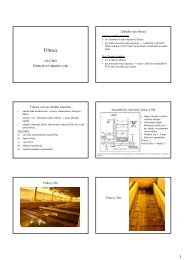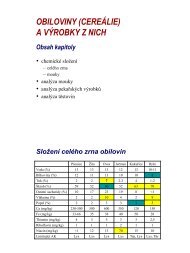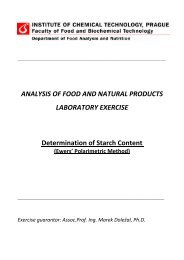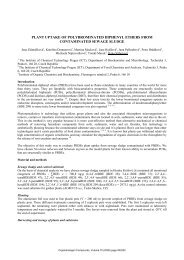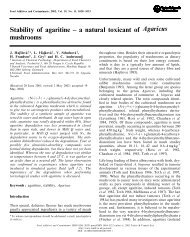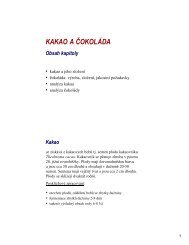The three-dimensional structure of humic substances and soil ...
The three-dimensional structure of humic substances and soil ...
The three-dimensional structure of humic substances and soil ...
You also want an ePaper? Increase the reach of your titles
YUMPU automatically turns print PDFs into web optimized ePapers that Google loves.
~749 ~54<br />
Fig. 10a-e. <strong>The</strong> enlarged section <strong>of</strong> a void in an organo-mineral com-<br />
plex (V; geometry <strong>and</strong> energy optimization: bonds <strong>and</strong> angles, torsions,<br />
van de Waals forces, hydrogen bridges) is shown in which atrazine is<br />
trapped <strong>and</strong> fixed via a distinct hydrogen bond <strong>and</strong> SOM is bound to<br />
the mineral matrix via hydrogen bonding in addition to <strong>three</strong> covalent<br />
bonds, a Section (Sticks, Atoms, Number) is shown with the displayed<br />
selected distances between atrazine I <strong>and</strong> II <strong>and</strong> III are as<br />
follows:<br />
Starting from C1 (i, I) (atom 1, molecule I) the dis-<br />
tances to H (256, III) are 0.7947 nm (HyperChem ® out-<br />
put 7.947477 Angstrom), to H (255, III) 1.0466 nm, to O<br />
(225, III) 0.3737 nm, O (187, III) 0.3431 nm, O (100, III)<br />
0.8717 nm <strong>and</strong> to the hydrogens <strong>of</strong> the long aliphatic<br />
chain (see lower part <strong>of</strong> V in Fig. 9) H (1004, II)<br />
0.6051 nm <strong>and</strong> H (1011, II) 0.8632 nm. From H (3, I) to<br />
H (950, II) a distance <strong>of</strong> 0.3074 nm, to H (996, II) <strong>of</strong><br />
0.2160 nm <strong>and</strong> to H (1004, II) <strong>of</strong> 0.4177 nm was measured<br />
for the lower part <strong>of</strong> the void. In the upper part, for in-<br />
stance between H (17, I) <strong>and</strong> H (902, II) 0.3074 nm, H<br />
(749, II) 0.4468 nm, H (745, II) 0.6537 nm, C (400, II)<br />
0.7601 rim, O (577, II) 0.4885 nm were obtained. Despite<br />
the apparent proximity between H (19, I) <strong>and</strong> H (251, III)<br />
a distance <strong>of</strong> 1.1614 nm was found <strong>and</strong> clearly demon-<br />
strated the necessity <strong>of</strong> exactly calculated coordinate<br />
systems. Moreover, the distance between H (21, I) <strong>and</strong><br />
O (606, II) was <strong>of</strong> interest, because it narrowed with<br />
progressing geometry optimization from >1rim to<br />
0.2221 nm generating a hydrogen bond which immobi-<br />
lized the atrazine molecule in the HA void. <strong>The</strong> more the<br />
total energy content <strong>of</strong> the organo-mineral complex V is<br />
/<br />
1<br />
6<br />
4<br />
6~4 "~<br />
71<br />
atoms labelled by numbers; b Section (Sticks, Atoms, Symbols) is<br />
shown with atoms labelled by element symbols; c Section (Rendering;<br />
Disks, Perspective) is shown as colour plot illustrating the space re-<br />
quirements <strong>of</strong> the pesticide <strong>and</strong> the available <strong>three</strong>-<strong>dimensional</strong> trap-<br />
ping space<br />
lowered, the more shrinking <strong>of</strong> the hollow space <strong>and</strong> con-<br />
sequently stronger bonding <strong>of</strong> the atrazine is observed. In<br />
summary, one can assume that without operator interfer-<br />
ence energy minimization simulates aging processes.<br />
<strong>The</strong> results <strong>of</strong> the <strong>three</strong>-<strong>dimensional</strong> <strong>structure</strong> <strong>and</strong> dis-<br />
tance measurements furthermore allow to evaluate the<br />
space between the trapped molecule <strong>and</strong> its host, the<br />
organo-mineral complex. In particular the space filling <strong>of</strong><br />
trapped biological or anthropogenic <strong>substances</strong> is sup-<br />
posed to have an essential influence on their presumable<br />
fate in SOM. Clearly air (N2, O2) <strong>and</strong> water (HzO) <strong>and</strong><br />
small organic acids (CH3COOH) can invade the gaps be-<br />
tween the pesticide <strong>and</strong> organic or inorganic <strong>soil</strong> surfaces.<br />
Thus, non-metabolic decomposition processes are easily<br />
possible at this stage. Metabolic processes, however, can<br />
be excluded as microorganisms such as bacteria (> 200 to<br />
1000 nm) <strong>and</strong> fungi (> 10000 nm) have no access into the<br />
described voids <strong>and</strong> even enzymes are too large to react<br />
with the trapped materials when the front <strong>and</strong> back side<br />
<strong>of</strong> the void is closed by recalcitrant SOM or inorganic<br />
<strong>substances</strong>. <strong>The</strong> latter is much more likely, as the organic<br />
matter in agricultural <strong>soil</strong>s is only around 3°70. Thus, in<br />
nature the inorganic matrix represented here by the<br />
hypothetic model III should be larger by at least a factor<br />
<strong>of</strong> 30.



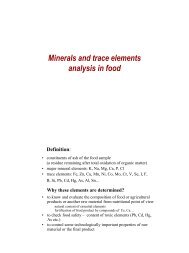
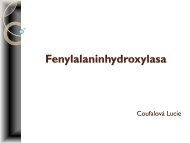

![Legislativa - Označování potravin [režim kompatibility]](https://img.yumpu.com/15533670/1/190x135/legislativa-oznacovani-potravin-rezim-kompatibility.jpg?quality=85)
